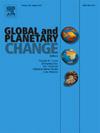气候-海洋不稳定促进了早寒武纪海洋的生氧扩张
IF 4
1区 地球科学
Q1 GEOGRAPHY, PHYSICAL
引用次数: 0
摘要
早寒武纪(~ 539 ~ 514 Ma)见证了地球历史上大气-海洋氧水平和生物多样性的戏剧性演变。早期生命的更替通常与气候环境因子有关,但在这一关键时期,气候、海洋环流和氧化还原动力学之间的详细联系尚不完全清楚。本文综合记录了华南扬子地块下寒武统筇竹司组页岩的Li同位素组成(δ7Li)、Zn同位素组成(δ66Zn)等元素地球化学数据。这些结果与以往不同沉积背景下的资料相结合,揭示了南海盆地中2 ~ 3世纪(~ 526 ~ 514 Ma)海底含氧水团剧烈膨胀后浅水氧化的详细记录。结合气候条件,认为凉爽的气候与强烈的风流同步可能促进了海水循环和海洋上升流的活跃,从而解耦了地表水和底水之间的氧化还原演化。高初级生产力和开放海洋上升流增加的硫酸盐供应导致了水柱和光带广泛分布的藻质。然而,富氧海底的建立和伴随的P再生进一步维持了高生物生产力,并促进了有机碳的埋藏,从而启动了地表水氧合的正反馈。该研究为调和浅水和深水的非均质氧化还原记录提供了一个窗口,并揭示了早寒武世海洋动态氧化还原景观的多种相互作用机制,这些机制对生物进化具有重要影响。本文章由计算机程序翻译,如有差异,请以英文原文为准。
Climatic-oceanic destabilization facilitated the euxinic expansion in the early Cambrian oceans
The early Cambrian (∼539–514 Ma) witnessed the dramatic evolution of atmospheric-oceanic oxygen level and biodiversification in Earth history. The turnover of the early life has been generally linked to climato-environmental factors, yet the detailed linkages between climate, oceanic circulation, and redox dynamics during this key interval are not fully understood. Here, we present the comprehensive records of Li isotope composition (δ7Li), Zn isotope composition (δ66Zn) and other elemental geochemical data of the lower Cambrian Qiongzhusi Formation shales in the Yangtze Block, South China. These results combined with previous data in diverse depositional settings reveal the detailed record of severe expansion of bottom euxinic watermass followed by progressive shallow-water oxygenation in the marginal-marine Nanhua Basin from the middle Age 2 to Age 3 (∼526–514 Ma). Correlating with the climatic condition, we propose that the cool climate in sync with intense wind-flow may facilitate the invigorated seawater circulation and oceanic upwelling, which decoupled the redox evolution between surface water and bottom water. The high primary productivity and sulfate supply augmented by upwelling of open ocean caused the widespread euxinia in water column and photic zone. However, the establishment of euxinic seafloor and concomitant P regeneration further sustained the high bioproductivity and contributed to the burial of organic carbon, which in turn initiated the positive feedback in oxygenation of surface water. This study provides a window to reconcile the heterogeneous redox records between shallow water and deep water, and highlights the multiple interacting mechanisms for dynamic oceanic redox landscape during the early Cambrian, which significantly influenced the biological evolution.
求助全文
通过发布文献求助,成功后即可免费获取论文全文。
去求助
来源期刊

Global and Planetary Change
地学天文-地球科学综合
CiteScore
7.40
自引率
10.30%
发文量
226
审稿时长
63 days
期刊介绍:
The objective of the journal Global and Planetary Change is to provide a multi-disciplinary overview of the processes taking place in the Earth System and involved in planetary change over time. The journal focuses on records of the past and current state of the earth system, and future scenarios , and their link to global environmental change. Regional or process-oriented studies are welcome if they discuss global implications. Topics include, but are not limited to, changes in the dynamics and composition of the atmosphere, oceans and cryosphere, as well as climate change, sea level variation, observations/modelling of Earth processes from deep to (near-)surface and their coupling, global ecology, biogeography and the resilience/thresholds in ecosystems.
Key criteria for the consideration of manuscripts are (a) the relevance for the global scientific community and/or (b) the wider implications for global scale problems, preferably combined with (c) having a significance beyond a single discipline. A clear focus on key processes associated with planetary scale change is strongly encouraged.
Manuscripts can be submitted as either research contributions or as a review article. Every effort should be made towards the presentation of research outcomes in an understandable way for a broad readership.
 求助内容:
求助内容: 应助结果提醒方式:
应助结果提醒方式:


